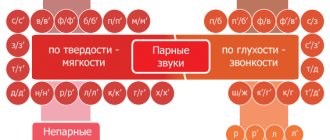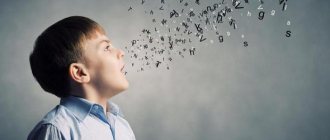Stages of work on sound educational and methodological material on correctional pedagogy (group) on the topic
Stages of working on sound
When forming correct sound pronunciation, it is proposed to comply with a number of general requirements for the sequence of stages of speech therapy work. Stage I. Preparatory stage: · Development of auditory attention and phonemic perception of the generated sound; · Formation of articulatory (speech motor) skills and abilities (articulatory gymnastics). Stage II. Formation of primary pronunciation skills: - sound production; — sound automation; - differentiation of formed and mixed sounds. Stage III. Formation of communication skills (accurate use of speech sounds in all communication situations). Automation of the delivered sound must be carried out in a strict sequence: 1. automation of sound in syllables (direct, reverse, with a combination of consonants); 2. automation of sound in words (at the beginning of the word, in the middle, at the end); 3. automation of sound in sentences; 4. automation of sound in pure sayings and poetry; 5. automation of sound in short and then in long stories; 6. automation of sound in spoken language. In this system, the starting point is the syllable and its place in the word. Depending on the type of sound being made, in one case, first, direct syllables are taken, and then reverse ones (producing the sounds [Ш], [Ж], [С], [З]), and when producing the sound [P], the reverse syllables are first practiced, and then straight. For example, this is what the sequence of automation and differentiation of whistling sounds looks like. Sounds [C], [C'] - [З], [З']: 1. sound [C] in a direct stressed syllable at the beginning of a word. 2. sound [C] in a direct stressed syllable in the middle of a word. 3. sound [C] in a direct unstressed syllable at the beginning of a word. 4. sound [C] in a direct unstressed syllable in the middle of a word. 5. sound [C] in a direct syllable with a combination of consonants. 6. sound [C] in a reverse stressed syllable. 7. sound [C] in a reverse unstressed syllable. 8. sound [C] in various positions. 9. sound [C'] in stressed syllables. 10. sound [C'] in unstressed syllables. 11. sound [C'] with a combination of consonants. 12. Differentiation of the pronunciation of sounds [C] - [C']. 13. Sound [З] in a direct stressed syllable. 14. The sound [З] in a direct unstressed syllable and with a combination of consonants. 15. Sound [Z] in reverse syllables. 16. Sound [З'] in various positions. 17. Differentiation of the pronunciation of sounds [Z] - [Z']. 18. Differentiation of the pronunciation of sounds [C] - [C'] - [Z] - [Z']. Complication of lexical material within the framework of “isolated sound/text” occurs at each correctional lesson. At each lesson, tasks are given that require the child to make statements of varying independence (and, therefore, difficulty): conjugate, reflected repetition, independent naming, creative search for answers with grammatical formatting of statements.
Sequence of work on sounds
Sequence of work on sounds
(consultation for parents)
Prepared by teacher-speech therapist Safonova T.A.
When forming correct sound pronunciation, a number of general requirements for the stages of speech therapy work are traditionally observed. There is a certain sequence in which sounds are introduced into speech. First, “simple sounds” are put: A, U, O, I, E, Y; B (B), P (P'), M (M'), V (B'), F (F'). After these sounds appear in the child’s independent speech,
work on: T (Tb), D (Db), N (Nb), K (Kb), G (Gb), X (Hb), Y, S (Sb), Z (Zz), Ts. The next step is to introduce sounds Sh, Zh, Ch, Shch, L (L). And only at the very end is the sound P (Рь) placed. This sequence is due to the readiness
articulatory apparatus to a specific sound.
For example, the sound Ш requires the tip of the tongue to rise upward. If your child’s tongue is not yet strong enough to lift it, then you should start not with sound production, but with strengthening the tongue, through special speech therapy massage and articulatory gymnastics.
In individual cases, the sequence of sound production may
change. For example, if the period of production of whistling sounds (S, Z, C) is delayed, and the tongue is already ready for hissing sounds, then you can try to put
them first, and then return to the whistling ones. There are also cases when a child, in
due to age, he is unable to control his articulatory patterns, and he begins to react too emotionally to failures, you can move on to producing the sounds that work best for him. This will avoid the occurrence of negativism towards classes. However, violation of the sequence of sounds is
AN EXCEPTION.
There are also controversial situations that are worth special mention. Sometimes you hear from parents: “We don’t need the sound S and Sh, we are interested in the sound R.” But you should not put your interests above the interests of the child. Maybe you
he is not interested, but a child will have a hard time without pronouncing them correctly... Moreover, not being able to pronounce other sounds correctly, it is unlikely
the child will be able to master the sound R. In addition, in the process of speech therapy classes with children it is provided
a certain sequence of work with each sound:
1. Preparation of the articulatory apparatus
2. Primary sound production
3. Consolidating it in oral speech
Each specific sound requires a set of special exercises
– articulation gymnastics. Doing exercises. The child must actively and
work consciously, while he should be interested.
By doing articulation exercises daily, you continue to work on the sound until correct articulation and pronunciation appear. When a child has mastered a new sound, do not demand that he immediately begin to use it in speech. The child must repeat an isolated sound many times, sometimes for many days, so that correct articulation becomes familiar to him.
For a child, this should not become a tedious and boring task, so different play exercises are chosen, which alternate and change.
The sequence of introducing sounds into speech follows one line: from
syllable to a word, to a sentence. However, there are little secrets when choosing
speech material during the automation of certain sounds. Thus, practicing the sounds “S”, “Sh” (as well as “Z”, “Zh”, “Shch”, “X”, that is, any consonant sound pronounced for a long time), begins with a long isolated pronunciation of them, then the transition to direct syllables like SA, SY, SHA, SHI. When pronounced correctly, the articulation of the sounds “S” and “Sh” is clearly visible, and it is easy to monitor the position of the tip of the tongue. Next, we move on to pronouncing words with practiced syllables at the beginning of the word: SANI, SHina, SALO, SON, Shapka...
After automating the sounds “S” and “SH” in such words, you can move on to other syllables (SU, SO, SHO, SHU) and words with these syllables. Then the work continues on the material of sound combinations such as ASA, ASHA, YSHA, OSY, ISA, etc., that is, the sound is between vowel sounds. In this case, it is necessary to pay attention to the fact that these sounds are never practiced at the same time (the system of work is simply identical).
Next, we move on to words like PORridge, KISS, SCALES, BRAIDS,
BURDEN... At this stage, pure language helps a lot. They are easy to compose yourself.
The principle is this: we choose any word in which the sound being studied will not be the last and not the first, for example: stripe, “tear off” the last syllable SA and compose a clean sentence something like this: “SA-SA-SA, there’s a stripe on the road” or a very simple “SA “SA-SA is a streak.” The main thing is that when pronouncing such
in pure language, the child could repeat for a long time some syllable with the sound being studied and
then enter it into a word. Then we move on to pronouncing words in phrases and then in sentences (we use materials from speech therapy notebooks, collections, or just children’s books). Along with this
type of work, it is necessary to include sound in short and then long poetic texts. This is how the transition to automation is carried out systematically
sound in speech (this is when you need to ask the child to monitor the correct pronunciation of the sound in all words).
Sounds that are pronounced briefly, as if exploding (“K”, “G”, “C”, “Ch”,
“T”, “D”) are recommended to be automated in a slightly different order. At first it's like this
and - in isolation, “Ch-Ch-Ch” - the train knocks on the rails, “K-K-K” - the grandfather grunts. Then these sounds are pronounced in reverse syllables: in first place is
vowel sound, and then our studied consonant sound: we sing the vowel for a long time, and we pronounce the consonant briefly, easily, like this: A-A-ACH, A-A-AK... When this type of syllables is easy to pronounce, then you need to immediately introduce pure phrasing ( we come up with it according to the principle described above). Next, we move on to combinations such as ACA, ACHA and words with this combination of sounds. We gradually introduce direct syllables into classes: CHA, KA, TSY and words with these syllables. Then he pronounces any words in phrases and sentences, and then we move on to practicing sounds in independent speech.
You can work on the sound “L” using any of the presented models, based on the child’s capabilities - you need to try everything. The "R" sound is an interesting sound. Someone very easily begins to crack their tongue right away and immediately produces syllables such as RA, RO, RU and soon words. In such cases, sound is easily introduced into phrases, sentences, and even into speech. However, as a rule, this sound causes serious difficulties during automation: the child does not have enough strength to pronounce it loudly and then the sound is lost somewhere in the oral cavity, pronounced as if in a whisper, muffled. Such a sound cannot be introduced into syllables and words; it is necessary to practice isolated pronunciation for as long as possible (crackling your tongue for a long time with your mouth wide open, as soon as possible). If the sound was produced from the push sounds T or D, then you need to pay close attention to the transition from these sounds to other push sounds. In practice, this type of work will look like this:
· Pronouncing the sound “R” in the syllables TRA, DRA, DRU, then in words with this syllable at the beginning (GRASS, FIGHT...), in the middle (vaTRUSHKA, MATRAS...), in phrases and in sentences with practiced words.
· Transition to the sound combination PRRR, BRRR (learn to make a crack from a new push sound - P or B), then practice in the syllables PRA, BRA, PRO, BRU, then in words with these syllables.
· Transition to the sound combination KRRR, GRRR, VRRR, NRRR (learn to make cracking noises from new pushing sounds), then practice in the syllables PRA, BRA, PRO, BRU, VRA, GRA, KRU...further in words with these syllables.
· Transition to the combinations ARA, ARO, ARU... If you still can’t “tear off” the sound “R” from the push sound, then go to the push “Sh” - SHRR (this is very difficult to pronounce and the child will gradually remove the “Sh”)... more in words with these combinations.
· Then we move on to automating sound in any position in words, in tongue twisters, tongue twisters. That is, all further work is carried out as usual: the sound “R” is automated in words, in sentences, sound is introduced into speech.
Question: soda and meth characteristics of the sub-stage of work on sound
Question: soda and meth characteristics of the sub-stage of work on sound
Work on sound Includes 5 stages: 1. Preparatory stage 2. Sound production 3. Sound automation 4. Sound differentiation 5. Introducing sound into independent speech
3 Preparatory stage Goal: preparing the auditory and speech-motor analyzers for sound production. Exercises are carried out aimed at developing: articulatory motor skills; speech breathing; voice guidance; Phonemic processes.
4 Sound production Goal: formation of the correct articulatory structure of an isolated disturbed sound. Methods of production: From preserved sound By decomposition of articulation By imitation Mechanical method Mixed
5 Areas of work: 1. Development of auditory perception. Purpose: to clarify the auditory image of the sound being practiced. 2. Development of phonemic analysis. Goal: highlighting the sound being practiced against the background of the word, clarifying its auditory-pronunciation image. 3. Development of speech articulatory motor skills. Goal: to clarify the articulation of the sound being practiced based on visual, tactile perception and kinesthetic sensations; practicing each element of the required articulatory structure. 4. Work on direct sound production. Goal: combining isolated articulatory elements into a single articulatory structure.
6 Automation of sound Goal: consolidation of conditioned reflex speech-motor connections on various speech material; introduction of sound into syllables, words, sentences, coherent speech.
7 Areas of work: 1. Introduction of sound into syllables, words, phrases, connected speech (the main direction of work). 2. Development of phonemic processes (phonemic perception, phonemic analysis and synthesis). 3. Work on the prosodic side of speech: on stress in the process of automating sound in words and syllables (a series of syllable chains with a moving stressed syllable are used); over tempo, rhythm, logical stress and intonation in phrases, sentences and coherent speech). 4. Vocabulary work (enrichment, clarification, activation and systematization of the dictionary). 5. Improving the grammatical structure of speech.
8 Sound differentiation Goal: development of auditory differentiation, consolidation of pronunciation differentiation, formation of phonemic analysis and synthesis. Substages are distinguished: 1. Preliminary stage of work on each of the mixed sounds 2. Stage of auditory and pronunciation differentiation of mixed sounds.
Stages Purpose Contents
Preparatory
Prepare speech-auditory and speech-motor analyzers for the correct perception and pronunciation of sounds 1. Formation of precise movements of the organs of articulation through articulatory gymnastics. 2. Formation of a directed air stream. 3. Development of fine motor skills of the hands. 4. Development of phonemic processes. 5. Practicing reference sounds
The question is repeated
Question 7: analysis and evaluation of the speech examination (using the example of 2 sections)
Anamnesis (its assessment according to the conclusion of specialists).
The following is revealed: the presence of hereditary burden; which is pregnancy; the course of this pregnancy in the first and second half; baby's cry; weight and height; date of discharge from the maternity hospital; features of early postnatal development; feeding.
Early psychomotor development (when he began to hold his head, sit independently, stand, walk, when the first teeth appeared).
Speech development (time of appearance and nature of humming, babbling, first words, phrases, course of speech development, speech environment).
Diseases suffered at an early age (before one year and after one year): somatic, infectious, bruises, brain injuries, convulsions at high temperatures.
Here are the anamnestic data that can be taken as the norm:
Heredity is not burdened, the pregnancy is the first or follows no earlier than a year after the previous one. The normal course of pregnancy in the absence of diseases and stressful situations. Labor occurred on time and without complications. The child immediately screamed. Height and weight were normal. Postnatal, early psychomotor and speech development are normal. Breastfeeding, absence of somatic, infectious diseases, diseases of the nervous system, bruises, brain injuries.
Anamnesis, slightly aggravated:
Pregnancy occurred earlier than a year after the previous one. Mild toxicosis during pregnancy. The baby's first cry after patting. The course of somatic and infectious diseases without complications in the early period of development, mixed feeding.
Anamnesis significantly aggravated by:
Compounded heredity (presence of neuropsychiatric diseases in parents, chronic diseases in mother). Complicated course of pregnancy (toxicosis in the first and second half of pregnancy, threat of miscarriage, somatic and infectious diseases, physical and mental trauma during pregnancy, contact with sick pets). Premature birth, pathology during childbirth (weak labor, rapid, protracted, dehydrated labor, obstetrics). Rhesus conflict. Asphyxia (white, blue). Deviations in weight and height in a newborn. Deviations in early postnatal development (weak sucking reflex, excessive regurgitation during feeding, choking). Artificial feeding. Delayed psychomotor and speech development. Severe frequent somatic and infectious diseases, bruises, brain injuries, convulsive readiness, diseases of the nervous system.
Below is an example of 2 sections:
The structure of the articulatory apparatus.
The examination was carried out in accordance with the methods available in speech therapy. All parts of the articulatory apparatus were checked. Features were noted in the structure of the lips, teeth, tongue, bite, hard and soft palate. Assessment of the state of the articulatory apparatus: “good” if no changes were observed, “satisfactory” if minor deviations in the structure were noted, “unsatisfactory” if significant or gross deviations in the structure were identified.
State of speech motor skills.
Motor skills, coordination and movements of facial and speech muscles were studied. The test was carried out according to the instructions (smile with teeth bared; raise, frown your eyebrows, close both eyes, right, left; stretch your lips forward, stretch into a smile, make your tongue narrow (with a sting), wide (with a spatula); raise the tip of your tongue to the upper lip, lower it to the lower one, lick the upper and lower lips with the tip of the tongue, move the tongue from the right to the left corner of the mouth (“pendulum”), click the tongue. When performing, accuracy and range of movements, uniformity of muscle work, the ability to switch and hold a pose were noted. Motor skills articulatory apparatus were assessed as follows: “skills are fully formed” if all tasks were completed, “skills are not fully formed” if the performance was incorrect or individual tasks were not completed. Assessment of coordination of movements, “coordination is good” if the movements were accurate, smooth, proportionate; “coordination is impaired,” if violations were noted in one of the named indicators; “coordination is grossly impaired,” if violations were noted in all indicators. Assessment of movements of facial and facial muscles: “expressive”, “amimic”, “hyperkinesis”,
Sound pronunciation
The pronunciation of vowels and consonants was studied under various conditions using a method generally accepted in speech therapy. Assessment of sound pronunciation: “single distortions”, “multiple distortions”, “single replacements”, “multiple replacements”, “lack of sound”. During the study, the qualitative aspect of each violation was recorded.
Question 8: prospect plan - Didn’t do it
question: soda and meth characteristics of the sub-stage of work on sound
Work on sound Includes 5 stages: 1. Preparatory stage 2. Sound production 3. Sound automation 4. Sound differentiation 5. Introducing sound into independent speech
3 Preparatory stage Goal: preparing the auditory and speech-motor analyzers for sound production. Exercises are carried out aimed at developing: articulatory motor skills; speech breathing; voice guidance; Phonemic processes.
4 Sound production Goal: formation of the correct articulatory structure of an isolated disturbed sound. Methods of production: From preserved sound By decomposition of articulation By imitation Mechanical method Mixed
5 Areas of work: 1. Development of auditory perception. Purpose: to clarify the auditory image of the sound being practiced. 2. Development of phonemic analysis. Goal: highlighting the sound being practiced against the background of the word, clarifying its auditory-pronunciation image. 3. Development of speech articulatory motor skills. Goal: to clarify the articulation of the sound being practiced based on visual, tactile perception and kinesthetic sensations; practicing each element of the required articulatory structure. 4. Work on direct sound production. Goal: combining isolated articulatory elements into a single articulatory structure.
6 Automation of sound Goal: consolidation of conditioned reflex speech-motor connections on various speech material; introduction of sound into syllables, words, sentences, coherent speech.
7 Areas of work: 1. Introduction of sound into syllables, words, phrases, connected speech (the main direction of work). 2. Development of phonemic processes (phonemic perception, phonemic analysis and synthesis). 3. Work on the prosodic side of speech: on stress in the process of automating sound in words and syllables (a series of syllable chains with a moving stressed syllable are used); over tempo, rhythm, logical stress and intonation in phrases, sentences and coherent speech). 4. Vocabulary work (enrichment, clarification, activation and systematization of the dictionary). 5. Improving the grammatical structure of speech.
8 Sound differentiation Goal: development of auditory differentiation, consolidation of pronunciation differentiation, formation of phonemic analysis and synthesis. Substages are distinguished: 1. Preliminary stage of work on each of the mixed sounds 2. Stage of auditory and pronunciation differentiation of mixed sounds.
Stages Purpose Contents
Preparatory
Prepare speech-auditory and speech-motor analyzers for the correct perception and pronunciation of sounds 1. Formation of precise movements of the organs of articulation through articulatory gymnastics. 2. Formation of a directed air stream. 3. Development of fine motor skills of the hands. 4. Development of phonemic processes. 5. Practicing reference sounds





